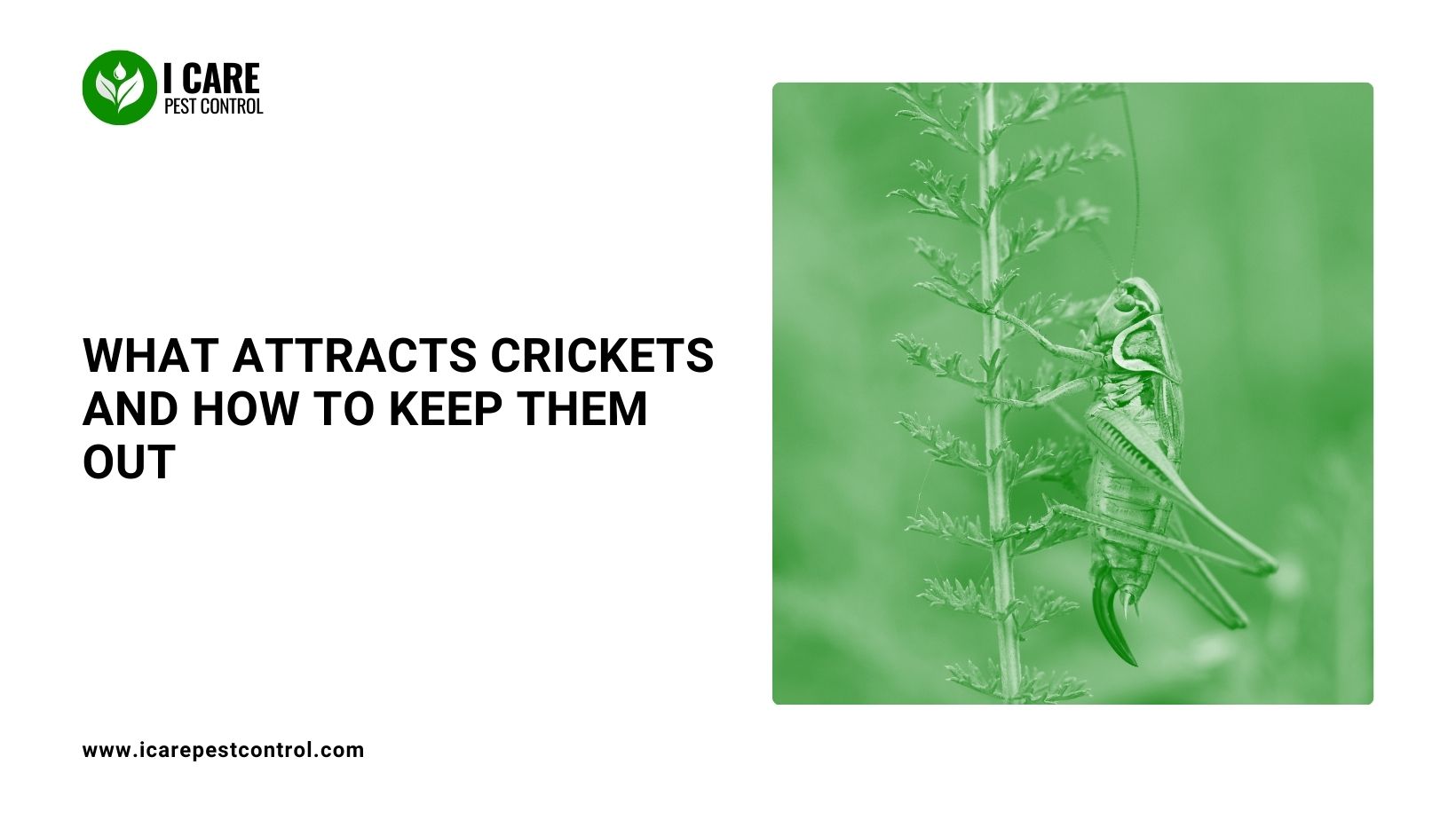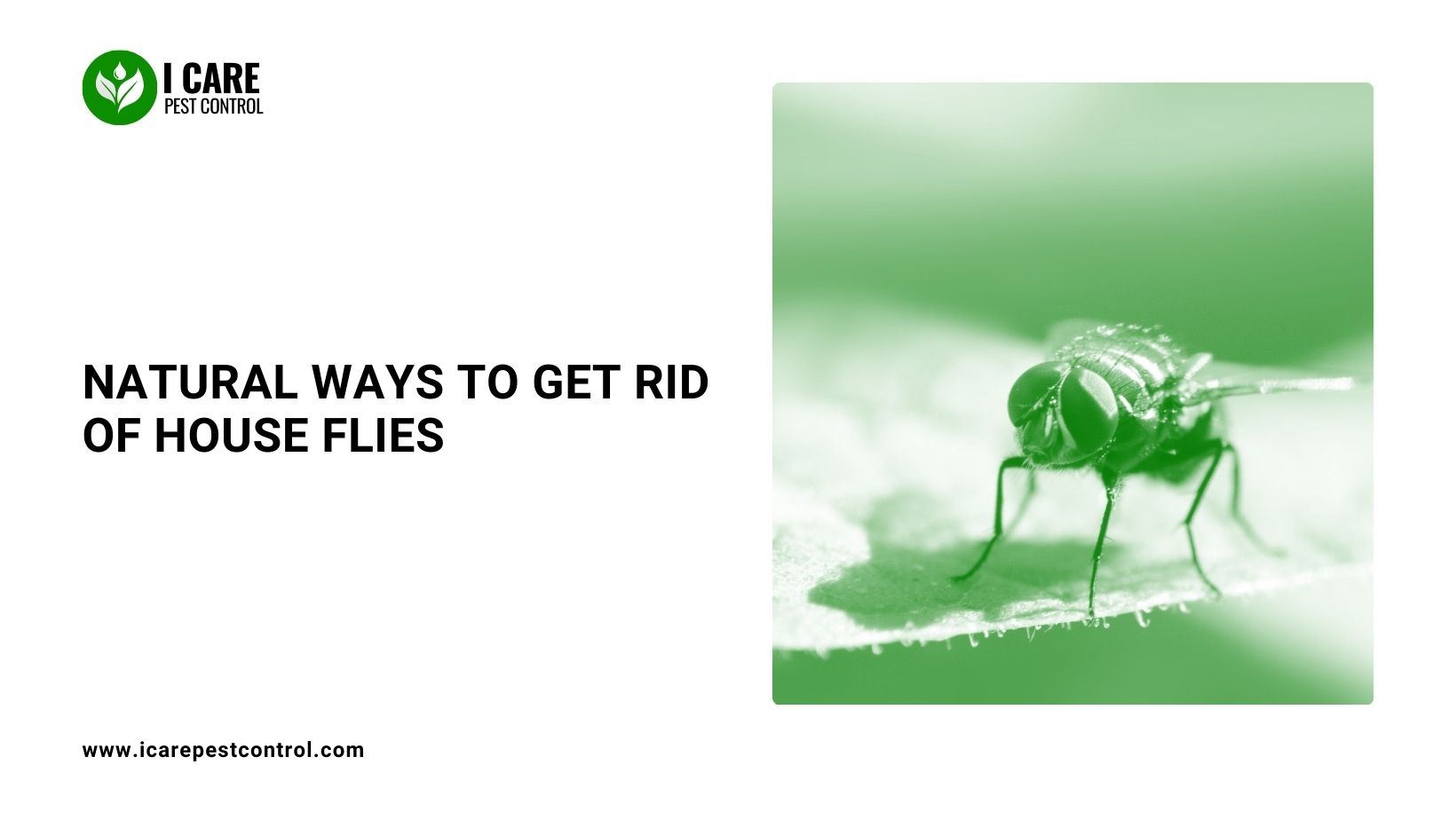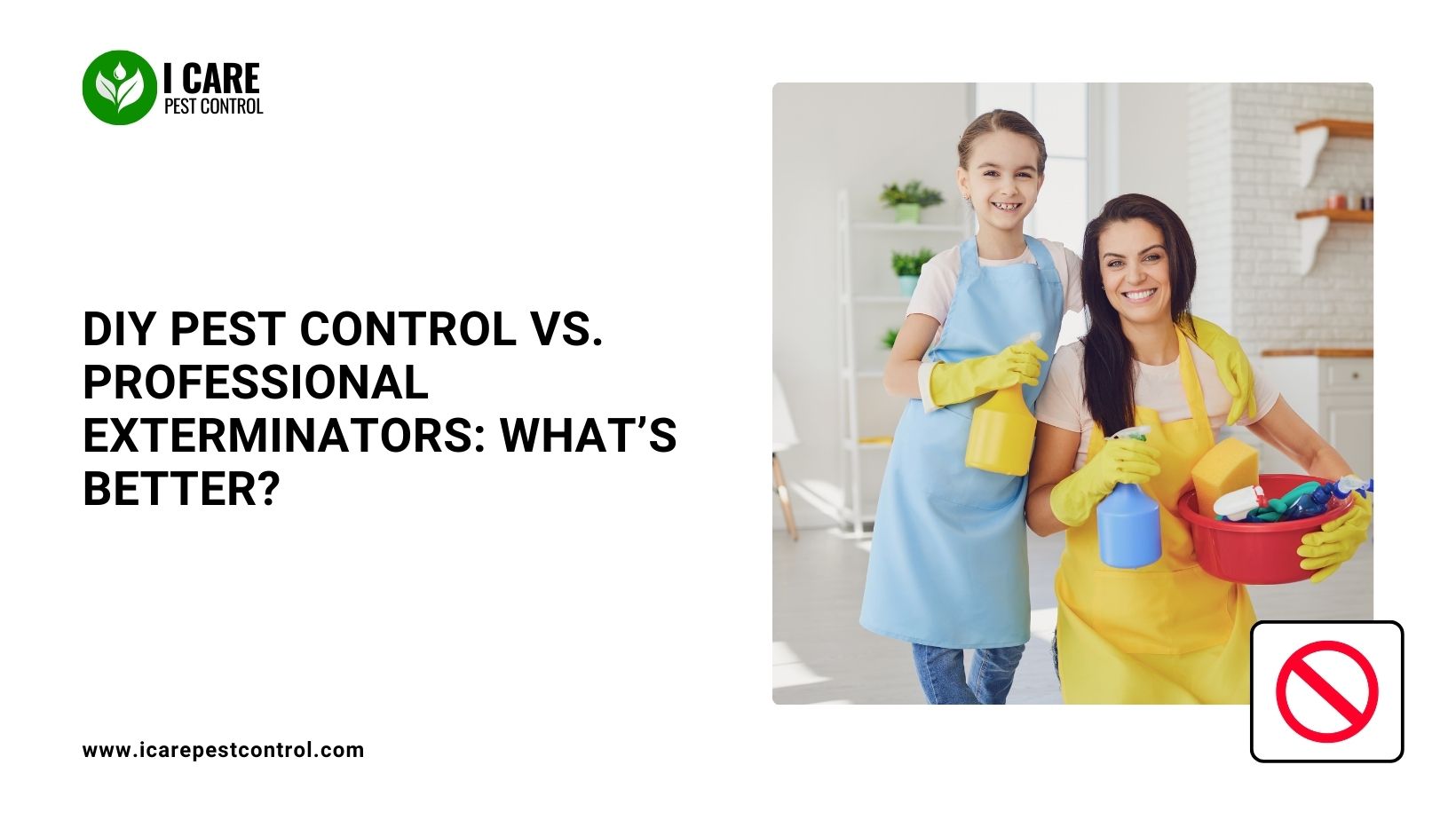Introduction The chirping of crickets may remind you of peaceful summer nights, but when these insects invade your home, they quickly become unwelcome guests. Understanding what attracts crickets is the first step in keeping them out of your living spaces. In this blog, I Care Pest Control explores the reasons crickets enter homes and natural, effective methods to keep them away. What Attracts Crickets: The Basics To effectively manage a cricket infestation, you must first understand what attract’s crickets. Crickets are typically drawn to environments that are warm, moist, and offer shelter. They are nocturnal and prefer dark areas with ample hiding spots. What Attract’s Crickets to Your Home Several factors explain what attract’s crickets to residential spaces: Light Sources: Bright lights, especially white or blue, attract crickets. Moisture: Crickets thrive in damp, humid conditions. Food: Crickets feed on organic materials, including fabric, paper, and even crumbs. Shelter: Cluttered basements, garages, and crawl spaces are ideal habitats. Knowing what attract’s crickets helps you eliminate these attractants and protect your home. What Attracts Crickets During Certain Seasons Crickets are more active in late summer and early fall. Cooler outdoor temperatures drive them indoors. Understanding what attracts crickets seasonally allows you to prepare your home in advance. Natural Ways to Repel Crickets Now that you know what attracts crickets, let’s explore natural methods to repel them. 1. Diatomaceous Earth Sprinkle food-grade diatomaceous earth in cricket-prone areas. It dehydrates insects upon contact. 2. Essential Oils Crickets dislike the strong scent of essential oils such as peppermint and clove. Mix with water and spray near windows and baseboards. 3. Seal Entry Points Understanding what attracts crickets includes realizing how they get in. Seal cracks and gaps in doors, windows, and foundations. What Attracts Crickets to Your Yard Outdoor areas often become breeding grounds. Let’s break down what attracts crickets to your garden: Tall Grass and Weeds: These provide ideal hiding and breeding spots. Woodpiles and Debris: Perfect shelters for crickets. Outdoor Lights: Especially white lights, which lure them in. Tending your lawn and switching to yellow outdoor lighting can help reduce what attract’s crickets to your property. What Attracts Crickets Inside Bedrooms and Kitchens Yes, even the most personal spaces aren’t safe. Understanding what attract’s crickets to bedrooms and kitchens includes: Food Spills: Crumbs and food residues. Dirty Laundry: Sweat and organic residue attract crickets. Moisture: Leaky faucets or humidifiers. Maintaining cleanliness is crucial when targeting what attract’s crickets indoors. What Attract’s Crickets to Dark, Quiet Places Crickets prefer silence and darkness. Understanding what attracts crickets to your storage areas can help you prevent infestations. Keep storage boxes sealed Use natural deterrents like cedar blocks Reduce What Attracts Crickets with Better Lighting Light plays a huge role in what attract’s crickets. Switch to sodium vapor or yellow bug lights that are less appealing to insects. What Attracts Crickets to Commercial Spaces Businesses aren’t immune. In commercial spaces, what attracts crickets includes: Overhead fluorescent lighting Breakroom food waste Warehouse clutter Regular inspections and professional pest control can significantly reduce what attracts crickets in business environments. Preventative Tips to Stop What Attracts Crickets Install door sweeps Dehumidify basements Trim outdoor vegetation Dispose of trash promptly Following these tips addresses what attract’s crickets and helps keep your home pest-free. Professional Help for What Attracts Crickets When home remedies aren’t enough, professional solutions are needed. At I Care Pest Control, we assess what attract’s crickets to your home and implement tailored strategies to eliminate them. Conclusion: Understand What Attract’s Crickets to Keep Them Out Knowing what attract’s crickets is essential for keeping them at bay. Whether it’s food, moisture, or shelter, eliminating these attractants can make your home a cricket-free zone. If you’re tired of hearing crickets chirp inside your house, it’s time to act. Trust I Care Pest Control to help you identify and eliminate what attract’s crickets from your space effectively and naturally. Contact us today to schedule a consultation and learn more about our eco-friendly pest control services. Let’s put an end to what attract’s crickets—together!
Natural Ways to Get Rid of House Flies
Introduction Flies are one of the most common and annoying household pests. Not only are they a nuisance, but they can also pose health risks as they carry bacteria and diseases. If you’re looking to rid of flies naturally, you’re in the right place. This blog by I Care Pest Control will guide you through natural, safe, and effective ways to keep your home fly-free without relying on harmful chemicals. Why You Should Rid of Flies Naturally Using chemical sprays may offer a quick fix, but they often contain toxins that can harm your family, pets, and the environment. That’s why many homeowners prefer to rid of flies naturally. Natural solutions are safer, sustainable, and often just as effective as chemical alternatives. Rid of Flies Naturally by Maintaining Cleanliness To effectively rid of flies naturally, start with maintaining cleanliness. Flies are attracted to food residues, garbage, and pet waste. Make sure to: Wipe down kitchen counters regularly Clean dishes promptly Take out the trash daily Keep pet areas clean A clean environment drastically reduces the chances of a fly infestation. Rid of Flies Naturally with Apple Cider Vinegar Trap This is a tried and tested method to rid of flies naturally. Take a bowl, fill it with apple cider vinegar, and add a few drops of dish soap. The vinegar attracts the flies while the soap breaks the surface tension, causing them to drown. How to Make It: Take a small bowl Add 1/2 cup of apple cider vinegar Add 2-3 drops of dish soap Cover with plastic wrap and poke small holes Place it where flies are most active and watch it work its magic. Rid of Flies Naturally Using Essential Oils Flies dislike certain scents. You can rid of flies naturally by using essential oils like: Lavender Peppermint Lemongrass Eucalyptus How to Use: Mix a few drops of essential oil with water Pour it into a spray bottle Spray around windows, doors, and fly-prone areas This not only repels flies but also makes your home smell amazing. Rid of Flies Naturally with Fly-Repelling Plants Nature has given us several plants that help to rid of flies naturally: Basil Mint Marigold Lavender Place these plants near doors, windows, and kitchen areas to create a natural barrier against flies. Use Cloves and Citrus to Rid of Flies Naturally This is a traditional remedy to rid of flies naturally. Flies hate the smell of cloves and citrus. How to Use: Cut a lemon in half Stick 6-12 cloves into each half Place them on a plate in fly-prone areas This method is especially useful for dining tables or kitchen counters. DIY Fly Paper to Rid of Flies Naturally Making your own fly paper is another effective way to rid of flie’s naturally. How to Make It: Mix sugar, honey, and water Soak brown paper strips in the mixture Let them dry slightly and hang them around your home Flies will get stuck on the paper, reducing their numbers. Rid of Flies Naturally by Cleaning Drains Flies often breed in moist areas like kitchen and bathroom drains. To rid of flie’s naturally, pour a mixture of baking soda and vinegar down the drain, followed by hot water. Do this weekly for best results. Rid of Flies Naturally with Mesh Screens Prevention is always better than cure. Installing mesh screens on windows and doors can rid of flies naturally by preventing them from entering in the first place. Rid of Flie’s Naturally by Managing Outdoor Lighting Flies are attracted to light. Reduce outdoor lighting or use yellow “bug” lights to help rid of flies naturally by decreasing their attraction to your home. Make Natural Fly Repellent Spray to Rid of Flie’s Naturally Ingredients: 1 cup water 1/2 cup witch hazel 10 drops of eucalyptus oil 10 drops of lavender oil Mix all ingredients in a spray bottle and use it in fly-prone areas to rid of flie’s naturally. Conclusion: Rid of Flie’s Naturally with I Care Pest Control Getting rid of flies doesn’t have to mean filling your home with chemicals. By following these natural methods, you can rid of flies naturally while keeping your environment healthy and safe. Whether it’s through maintaining cleanliness, using essential oils, or deploying homemade traps, I Care Pest Control encourages you to go the natural route. If these methods don’t completely solve the problem, consider reaching out to professionals like I Care Pest Control. We specialize in eco-friendly pest control solutions that are safe for your family and effective against all kinds of pests. Stay safe, stay fly-free, and always aim to rid’s of flies naturally!
DIY Pest Control vs. Professional Exterminators: What’s Better?
When it comes to dealing with pests in your home, one of the first questions homeowners ask is whether they should attempt DIY pest control vs professional exterminators. With the rise of internet tutorials and the availability of various pest control products at your local store, DIY pest control seems like a tempting, cost-effective solution. However, professional exterminators bring their expertise and experience to the table, making them an appealing option as well. In this article, we’ll compare DIY pest control vs professional exterminators and discuss the pros and cons of each approach. Whether you’re dealing with a minor infestation or a full-blown pest problem, knowing which method is better suited to your needs can help you make an informed decision. What Is DIY Pest Control? DIY pest control refers to the process of handling pest infestations on your own using store-bought products or homemade solutions. These can range from insect sprays, baits, and traps to natural remedies like essential oils, vinegar, or diatomaceous earth. The idea behind DIY pest control vs professional exterminators is that homeowners can save money by eliminating pests themselves without the need for professional intervention. Common DIY Pest Control Methods Include: Insecticides: Chemicals available in sprays or powders to kill pests. Traps: Simple mechanical devices or glue traps that capture pests. Natural Remedies: Homemade solutions like boric acid, essential oils, or vinegar. Exclusion Techniques: Sealing cracks, holes, and other entry points to prevent pests from entering. DIY methods are often marketed as convenient, affordable, and simple solutions for minor pest issues. What Is Professional Pest Control? Professional exterminators are licensed and trained experts who use advanced techniques and professional-grade products to eliminate pests. Unlike DIY solutions, pest control services offered by professionals are comprehensive, often involving inspections, treatment plans, and long-term monitoring to prevent future infestations. Professional exterminators typically offer services for a wide variety of pests, including rodents, termites, ants, cockroaches, bed bugs, and more. They have the expertise to diagnose the type of infestation, locate hidden nests, and choose the most effective treatments for long-term results. Professional Pest Control Services Include: Inspection: A thorough inspection to identify pest species, nesting sites, and potential entry points. Customized Treatment Plans: Tailored pest control solutions based on the severity of the infestation. Ongoing Monitoring: Regular follow-up visits to ensure that pests don’t return. Integrated Pest Management (IPM): A combination of chemical, biological, and environmental strategies to control pests while minimizing risks to health and the environment. DIY Pest Control vs Professional Exterminators: Cost Comparison One of the main reasons homeowners choose DIY pest control vs professional exterminators is cost. DIY solutions may seem more affordable, with pest control products available for as little as a few dollars. For small infestations, it might appear reasonable to handle the issue on your own. However, this can be misleading when you factor in the long-term costs. DIY Pest Control: Initial Costs: The upfront cost of DIY pest control products is typically lower. Ongoing Costs: With recurring infestations, you might have to purchase more products, which can add up. Ineffective Treatments: If the DIY methods don’t work, you could waste money on products that don’t solve the problem. Professional Exterminators: Initial Costs: The upfront cost of hiring a professional exterminator is higher than a DIY solution. Long-Term Savings: Professional services often come with a guarantee and long-term pest prevention, saving you money in the long run. Comprehensive Solutions: Professionals may eliminate pests more effectively, reducing the need for repeated treatments. While DIY pest control vs professional exterminators may have an initial cost difference, professionals typically offer more value in terms of effectiveness and long-term prevention. Effectiveness: DIY Pest Control vs Professional Exterminators When it comes to DIY pest control vs professional exterminators, the effectiveness of the treatment plays a significant role in choosing the right approach. DIY methods are often limited to surface-level treatments, while professional exterminators offer a more thorough, targeted approach. DIY Pest Control: Limited Effectiveness: DIY treatments might only kill visible pests and leave nests, eggs, or hidden infestations untreated. Pests can also become resistant to over-the-counter chemicals over time, reducing their effectiveness. Temporary Relief: While DIY methods might offer temporary relief, they often don’t address the root cause of the infestation, leading to recurring problems. Professional Exterminators: Comprehensive Treatment: Professionals can locate hidden nests, larvae, and eggs, ensuring that all stages of the pest life cycle are eliminated. Long-Term Results: Exterminators use powerful chemicals, baits, and techniques to not only kill pests but also prevent them from coming back. When comparing DIY pest control vs professional exterminators, professional services are usually far more effective at eliminating pests and preventing future infestations. Safety Considerations: DIY Pest Control vs Professional Exterminators Another important aspect of the DIY pest control vs professional exterminators debate is safety. Some pests are carriers of diseases, and using chemicals improperly can pose health risks to your family and pets. Inexperienced use of DIY products can lead to harmful exposure, contamination, or incorrect application. DIY Pest Control: Chemical Risks: Store-bought pest control products often contain harsh chemicals that can be hazardous to humans and pets if not used properly. Overuse of Products: In an attempt to solve the problem, homeowners may overuse chemical treatments, which can pose health risks and be ineffective in the long run. Professional Exterminators: Expert Application: Licensed professionals are trained to apply pesticides safely, using the correct amount and targeting areas where pests are most likely to be. Safety Protocols: Professional exterminators adhere to safety regulations and ensure that chemicals are safely stored and applied, minimizing the risk to your home and family. When considering DIY pest control vs professional exterminators, professional pest control services provide a safer, more controlled approach to pest elimination. Time and Convenience: DIY Pest Control vs Professional Exterminators When choosing between DIY pest control vs professional exterminators, time and convenience are often decisive factors. Homeowners may be tempted to try DIY methods because they seem quicker and more convenient. However, pest control can be



